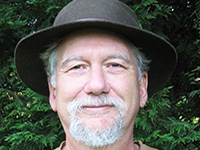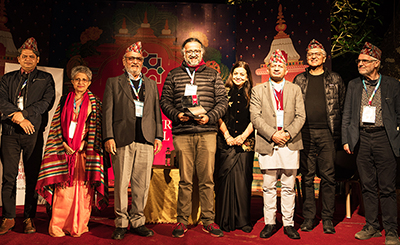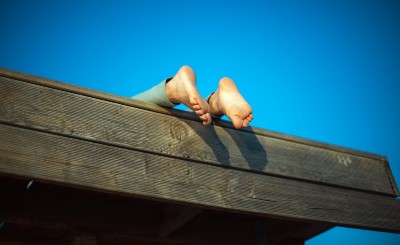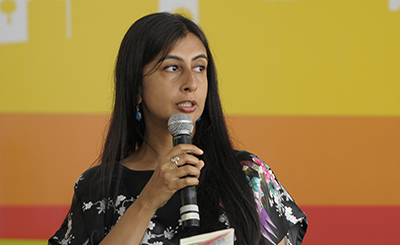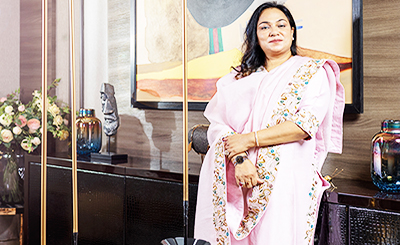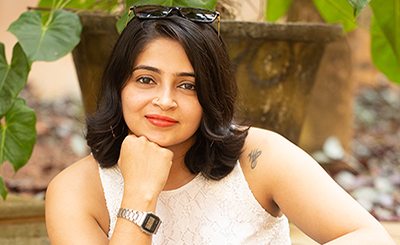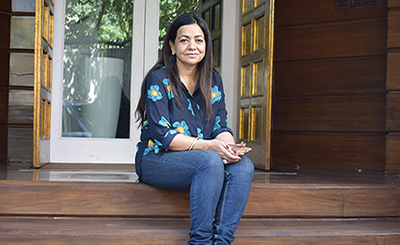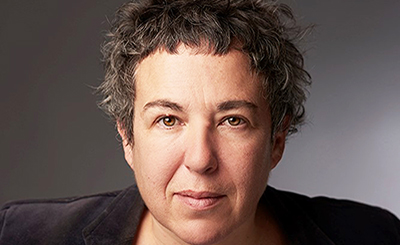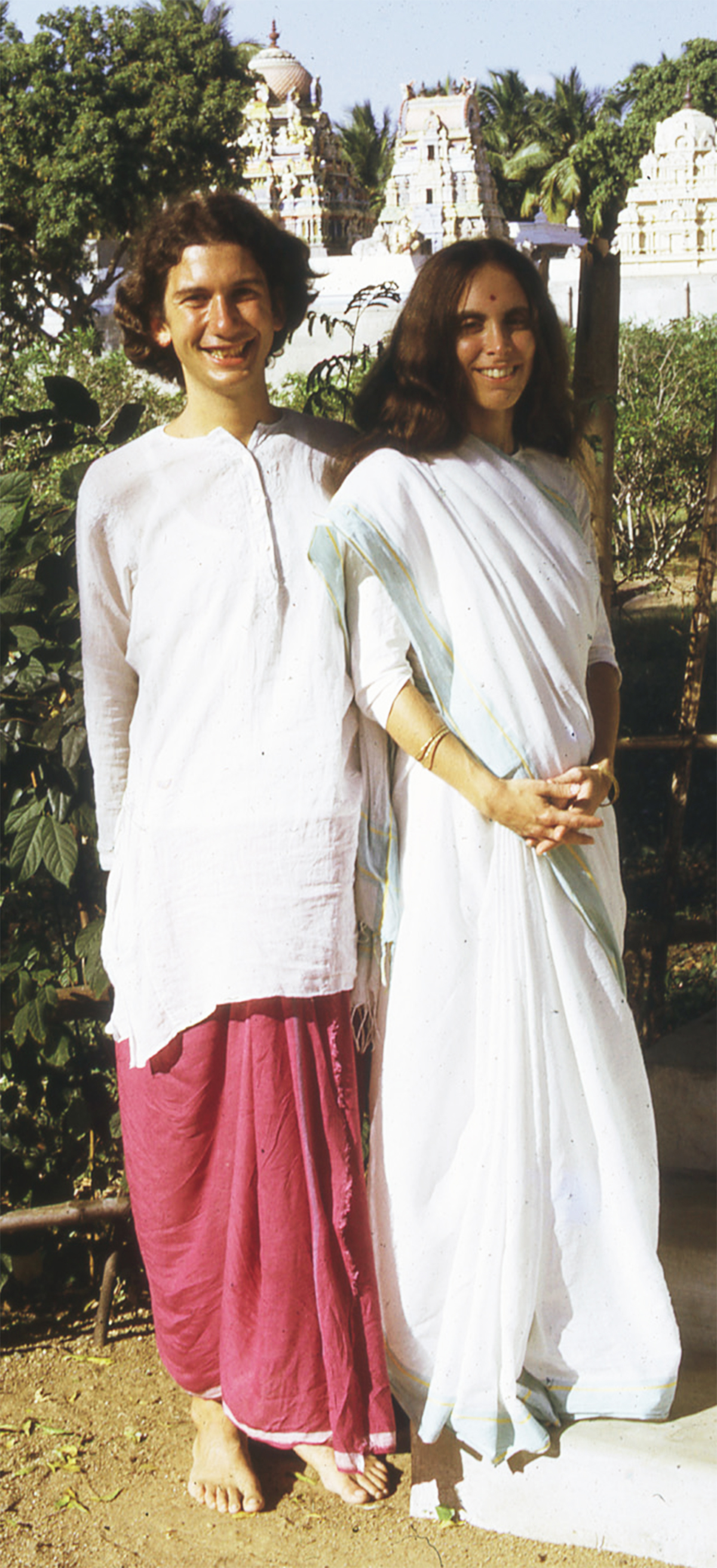
Robert McGahey with his wife Judi during their India sojourns that began in the late Sixties. Photo courtesy of the author.
Exclusive to The Punch Magazine: An excerpt from a forthcoming memoir that records a lifetime of sojourns to India: spiritual seeking, breathing in a bit of its heat and dust, weaving one’s way through its crushing crowds, trekking, consulting and writing
Author’s note: I stumble into India as an accidental tourist, an Asian Tour tenor with the Harvard Glee Club in 1967. Later, I drag my bride there on our honeymoon, a pilgrimage that initiates the complex, sometimes funny, sometimes agonizing relationship of two Americans, each drawn deeply by Vedanta into a marriage of East and West on many levels. Our love affair and marriage, in which a passion for India is the driver and fulcrum, opens a wide window on the cross-cultural affair between American counterculture and Hindu South Asia, beginning in the late Sixties and extending into the millennium.
It all begins with a late-night taxi through the streets of Bombay, sidewalks littered with hundreds of bodies, all the way to the curb. This must be some kind of plague, but nobody told me. Despite my fear, deep down, I’m possessed. During a Fulbright year based in Malwa, studying khyal with the master Kumar Gandharva, I enter an underworld reflection of life in America, immersed in India’s smells and sights as well as the inexhaustible sound-world of North Indian vocal music. My newly awakened sexuality is swallowed by the mythic substratum of Hindu goddess figures during a period of instinctive celibacy. Intrigued by an invitation from Maurice Frydman to “join the fellowship of the undeceived,” I begin a lifelong effort to practise Advaita through self-inquiry as taught by Ramana Maharshi.
“I expect to reach enlightenment in this lifetime,” Judi tells me this the day I meet her. A few years later, I return to India with her, a medical doctor and yoga teacher who is skeptical, reluctant to share the experience of India with me. But as we hop between ashrams, she, too, falls in love with India. In the end, we are banished by the head swami, who tells us to go home, raise children, fulfill our work, and serve our parents. We can return after we complete these householder duties.
When we return to India in the Nineties, the tables have turned. I, once totally smitten, am dismayed by modern India, whereas Judi is ever more deeply enthralled, throwing herself into Sanskrit and taking a teacher, who renames her Geeta Jyothi. As our sons leave the house, she begins long winter ashram sojourns, contemplating vows of monkhood which threaten our marriage.
My memoir, India: A Love Story, has the potential to interest a wide audience of seekers: those who throng the “spirituality” section in the West — especially “India freaks,” their children, and the burgeoning readership of South Asian writers, particularly middle class Indians who remember the curious phenomenon of the “Amreekan hippy-sadhu.” I believe it will appeal to the followers of Ram Das, Ramana Maharshi, Swamis Chidananda and Krishnananda (Sivananda Ashram), and Vinoba Bhave — characters all — but especially of Kumar Gandharva and Sunderlal Bahuguna (Chipko), remarkable figures with whom our lives become intertwined.
After Durga drowned, Calcutta was all dark, rain, and winds, a lot of sleeping. . . My body and soul suddenly slept.
The encounter with Maurice in Bombay unhinged me, weakening the bonds between the separate parts of a self I had heretofore experienced as singular. Following the trail of shock and wonder after that first night’s ride through the corpse-ridden streets of Bombay, I had returned to enter a dream-reality. Though I sometimes stepped back to take stock, marking plateaus in the descent, the dream continued to lurk, leading me further and further into its depths.
The clerical strike which opened the way for meeting Maurice in Bombay had barely ended before it was time for the long fall break, the Dussehra and Diwali holidays. Stuart was heading south to be with Lynn, while I made plans for a northern itinerary to include Delhi, Benares, Allahabad, Calcutta — essentially crossing the Gangetic Plain, then back to Jaipur via Agra and the Taj. My Fulbright colleagues in Jaipur and Allahabad would host me, but most important was the plan to be in Calcutta for Durga Puja, celebrating the martial goddess especially dear to Bengalis with my Fulbright mates Jon and Loren at their tiny college on the outskirts of the megapolis.
The Batgods
On my way northeast, I visited the remote, beautifully preserved Buddhist site at Sanchi, which I shared with one lone student in his underwear, his clothes neatly hanging on a neem branch. The idyll ended when some boys threw firecrackers at me on my descent.
The next day, with my canteen of boiled water, I set out by horse-tonga for the nearby Udaigiri Caves at two in the afternoon. It was hot, incredibly still. The ride was rough, the board seat very hard. We soon left the little town far in the distance. The only sounds were the horse’s hooves striking the hard sun-baked clay road surface and the occasional gentle clucking of the driver as the horse backed a little on steeper grades. We entered a canyon with steep sheer walls, and the little village and its museum disappeared. Above, the sky was blue, eternal. Below, the horse toiled in the sun, shaking her head and whisking her tail in futile gestures against the flies. We arrived at the entrance to the caves. After motioning me towards it, the driver lay down in the shade of the mountain for an afternoon nap.
Inside the caves, I wandered from chamber to chamber. It was extremely quiet and still. This was unlike previous spelunking, comfortably enfolded within a chatty group with my parents and little sister within the Luray Caverns along the Skyline Drive in Virginia. I sought the expected religious images. None. Then I entered a large cave and was instantly overcome by the acrid smell of guano. I studied the expanse of the cave floor, which was thick with droppings. For a moment, I feared I would retch. My gaze climbed the cavern walls until I caught sight of a few bats, hanging in a clump near the edge of the chamber. Then, with a shudder I discovered that the entire ceiling was covered with hundreds of them. I imagined they were looking at me, but studying them, I saw that all but a few were sleeping.
It seems to me that what seized Puer in India was not only the inescapable spiritual trip, but more immediately the moods, tones, and textures of experience. The yogi’s ideal of a crystal-clear subtle body with no samskaras, the colorings or stains left by experiences governed by desire and fear, was Puer’s as well. To be an unconditioned man, that was it. Yet the desire for experience — and a romantic fascination with death — ruled him. Just a tiny incandescent spark on the sea of time.
Sure, Maurice had introduced him to bedrock Advaita, the yoga of discriminating real from unreal. And liberation from the ego’s petty concerns, the final Vedic ideal of moksha, was what ultimately drew all of us Western “hippy-sadhus.” But in those caves, Puer did not experience transcendence, rather the uncanny, the Other.
Puer was searching for the Nameless God behind the moment’s fleeting experience, behind the implacable azure sky on the afternoon’s journey, but here was something else: a god-in-the-moment, a priceless treasure to be noticed, feared — above all, valued. In that upward glance, he was not grasped by an Eternity oblivious to the evanescence of the moment, standing before and after time, but a momentary god whose nature could only be expressed in that particular moment.
The god of that moment as Puer looked overhead at the vast canopy of dark brown winged flesh covering the cavernous ceiling was those bats. Their presence in the shrine was sacred, more immediate than the images produced by the exquisite religious imagination of Medieval sculptors, east or west. He was their guest. This was the pilgrim’s lesson for the day.
But the heart of Puer’s pilgrimage still lay ahead of him: Durga Puja in Calcutta. Once again he would be a guest, and a marked man.
I boarded the train for Calcutta at Old Delhi station, which was absolutely jammed. I would guess four or five thousand souls milled about, carrying carts of baggage, thoroughly plied by hawkers weaving their way through the crowd. Though I had a reservation, I saw with alarm that my car was bulging with people, and pushed my way in. I never got used to the experience of a crushing crowd in India, and constantly marveled at natives’ ability to shove through with ease, like invertebrates.
The train was a modern diesel express, hewing to its schedule more closely than most. But in the middle of the Gangetic Plain the train hit something and screeched to a halt. I joined the group of men who disembarked. I immediately smelled the carnage, an odd intermixture of raw and cooked meat. Before me was the severed head of a bull, staring back huge-eyed, impassive, an image right out of Guernica. The whole front of the train was splattered with blood, entrails, limbs, and blobs of cattle flesh. A herd had wandered into the path of the hurtling train at a crossing, and fifteen or twenty animals had been killed. Some of the animals had been caught, dragged, and partially roasted under the train’s wheels. The farmer, who sat in shock and disbelief by the side of the train in a tattered turban, was ruined. We watched silently while members of the crew cleaned away the disemboweled kine.
Once the tracks were cleared our pilgrim-train again headed to Calcutta. Durga, the goddess whose festival we were steadily approaching, is one of several variants of Devi, the Hindu Ur-Goddess. Unlike other god-desses, she is never shown with a consort. Even Kali, the powerful goddess of destruction, is depicted dancing on Shiva’s ecstatic body. As I read in his biography, the great saint Ramakrishna had been Durga’s disciple, re-infusing a torrent of devotion into her temple at Dakshineshwar. She visited him there one day while he meditated at the delta where the Hoogly River empties into the Bay of Bengal, appearing as a lovely young mother holding a baby in tender embrace. But suddenly, transformed into the blazing-eyed All-Devourer, she crushed the infant’s head between her jaws and disappeared beneath the waves. Reading this right after my return, I shivered with fear and recognition like a child hearing a dark fairy tale, imagining the very spot where it happened, off the finger of land where the temple sits.
Ramakrishna’s vision is the aspect that Bengalis worship at Durga’s puja. Her wooden-framed papier-mache statue is a ten-armed terror riding on a lion’s back, weapons in each hand, stabbing to death a rather pitiful looking buffalo, the demon Mahishta, who once drove the gods out of the celestial kingdom.
My Fulbright buddy Jon was waiting at busy Howrah Station when I arrived, looking the all-American boy with his solid frame and ruddy cheeks — despite the flowing whites he wore. The huge station was wrapped in bridges and overpasses everywhere I looked. Seeing him, I ignored the coolies and the crush of people. We hugged in the midst of the crowd. I shouldered my “Bombay-pack,” a World War II US Army copy, and followed him to his motorcycle.
It was about twenty-five miles to the little college where he and Loren taught. The streets were packed: ten million people dancing, howling, milling in the streets along with the cows and goats and 800,000 taxicabs, pedicabs, bicycle rickshaws, battered double decker buses and 100,000 motorcycles. Thousands of images of Durga were erected all over Calcutta. Drums beat incessantly, smoke billowing from massive incense-logs, while priests sat rapt in ecstasy.
I roared around the mobbed, wild city behind Jon on his motorcycle. In the traffic and crush, I think we were almost killed three times. I felt such abandon I didn’t care. We watched a beautiful sunset down by the Hooghly and listened as the boatmen sang hauntingly sad songs — the time had come for daughters who had spent the Puja with their parents to return to their taskmasters.
At the end of a carnivalesque day, we went to Jon’s favorite restaurant, the Olympia, for dinner. We both ordered the Chateaubriand, at the incredibly low price of Rs 5.50 (seventy cents). It felt like enjoying contraband (though it was buffalo, not beef). Afterwards, he drove me to the relative quiet of the sleepy college in the countryside, moonlit with an occasional illuminated cloud, through coconut palms and lush paddies. Even in that remote place, I could occasionally hear bands of villagers singing and yelling as they accompanied Durga-carts down little muddy lanes.
At sundown the following day, Durga’s festival would come to an end, marked by the ritual drowning of the terrible Goddess. We rose at five a.m. to visit a neighboring village, paying our respects while drinking endless cups of chai and eating barfi. Some villagers Jon knew invited us to accompany them for Durga-ma’s final ride to the nearby creek for immolation. A man carefully explained that this drowning was for the purpose of reminding devotees that the image, so adored for ten days, was but an idol, to be cast aside for another year, while the spirit behind it was eternal and constant. It also seemed to me that it was necessary to quench the Dionysian fires which had been lit at this crazy festival, a religious carnival which seemed to have possessed an entire modern city. Several people will drown in the excitement. They do every year.
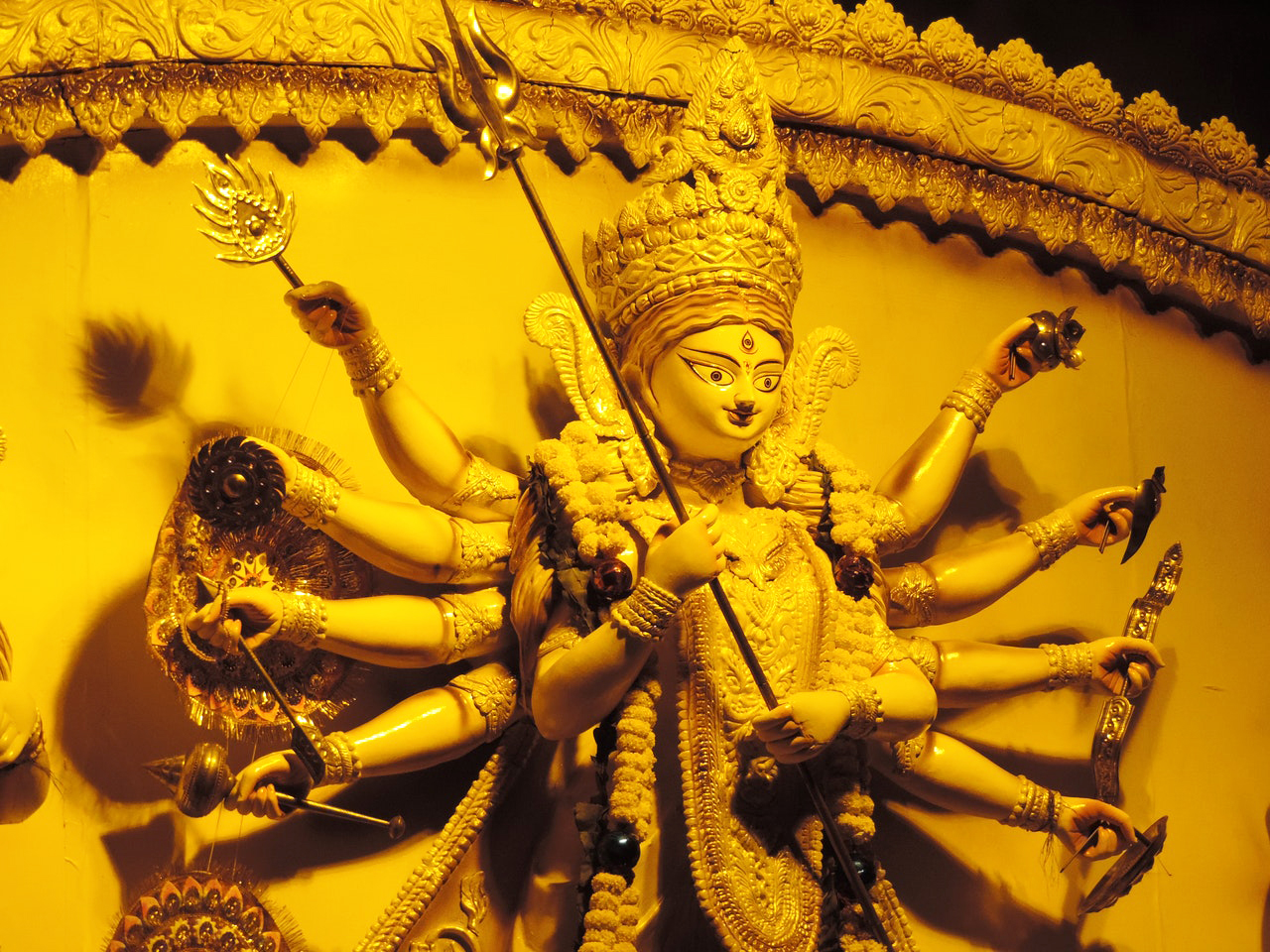
Late that afternoon, we mounted the bed of an old truck, along with the Goddess. I held onto the hooped frame, the skeletal structure which bounded and supported the ten-armed creature, chanting, along with the crew of young men and boys, Bengali cries of “long live Durga” and “long live Durgapur.” When it started to rain, I abandoned myself to the spirit of the occasion. Soaked and wildly happy, we cheered lustily as Durga was dumped off the rear of the truck. She sank slowly into the little creek. The water barely covered her hoop. They would know where to find her next year.
On the trip back to the village I stood behind the cab on the spot where Durga had rested, a throng of young men holding me — hanging onto my arms, legs, and fingers — as the truck lurched through muddy traces. They formed a human chain to keep from falling, and I felt like a colossus of sorts. The villagers complimented my steadiness.
“Sirrh, you very good,” said one boy about twelve, gesturing with his legs braced and arms outstretched, holding his head high. Others in the company laughed, and many of the boys still clung to me. A boy in his late teens added, “Yes, you are being strong for us. I think you are feeling jolly and liking this place?” I smiled. “Yes, I like it here very much. It is peaceful and lush. You are a happy village.”
A young boy blurted out, “Will you stay, sahib?” Others nodded their heads in unison, and the oldest man there, probably about thirty, gave me a formal invitation. “Yes, Robert, you must stay with us. We would be most honored.”
I shot a look at Jon, who was beaming, a little awed by all this. “But I must return to Indore and teach. Very soon.”
“Then come back,” said the first boy. “Yes, yes, yes,” they chanted. “You stay here, you part of our village” he added.
As Jon and I headed for the Harley, some of the smaller boys clung to my feet, while others pulled at my hands, each holding onto a finger like so many cow’s teats, which made it difficult for me to disengage. I felt like Gulliver. When we finally mounted the motorcycle, Jon turned to me.
“You know, Bob, they were kissing your feet.”
I must have looked quizzical.
“They were kissing your feet. It’s a gesture of extreme respect.”
We roared off as the deepening colors shaded into darkness. The rain had ceased, twilight had turned to evening, and the moon shone on our faces as we rode through the fragrant Bengali countryside, tall palms etched blackly against the night sky. I felt enormously blessed, and a little like a god myself.
But from the dreamside of the little stream, one might see Puer differently. Not a god, more like the eunuchs who still inhabit Durga’s temple in Calcutta, serving as her priests. Or the sacrificial bull Mahishta, entwined in Durga’s multiple arms.
After Durga drowned, Calcutta was all dark, rain, and winds, a lot of sleeping. My body and soul suddenly slept.
Up until the ritual drowning of the Goddess, events had moved at a frenzied pace. The ecstatic crowds and Jon’s Harley propelled me, but I had also been driven by a necessity to experience where all this led. That drive consummated, I now slept.
The next evening, sitting around the parlor of their thatched quarters amid the rice fields, Jon, Loren, and I smoked some harsh Orissan ganja. “This shit is terrible,” Loren said. Jon and I agreed, coughing violently. But its hallucinatory effects were powerful. That night, I dreamt:
The universe, the night-sky filled with stars. Overtones of a droning tanpura ascending, descending, then re-ascending again to higher and higher tonal realms. Stretching my range of hearing. I wonder each time if I can bear hearing pitches that go any higher. This isn’t a matter of aural pain, but rather of being stretched, becoming airier and airier. The essences of the tones emerge in richly colored geometrical shapes, outlined against the vast blackness. A sense of timelessness. I am alone and helpless. I become a grain of sand, then observe this grain lying among all the others, and this grainy self is marked, transformed: changing from black to gray to white. The beauty of it all is inexpressible. But also, Death comes several times, white-hot molten rods driving through my heart, over and over again.
Then, I have intercourse with hard, rasping drainpipes, ridged steel culverts, extremely unpleasant. But they change to Mother, and this intercourse is pleasurable at last.
Now I catapult through the vast, starry realm. I see a rag doll flying far into space, past the stars. The doll lands limp and akimbo, skirt flopping, on a braided rug before a warm, blazing hearth-fire, next to a large easy chair. The chair is empty, but next to it lies a pair of slippers, awaiting their Master. There is an awesome sense of Presence. I, the rag doll, feel incredibly comfortable and safe.
I awoke in the middle of the night and sensed that the place this doll had been flung was the Hearth of God. Actually, upon reflection it looked suspiciously like the rug, hearth, and chair in the “sun porch” at Gran Howard’s in Eastern North Carolina. This was Granddaddy’s chair by rights, and I remember him leaning forward, patiently shifting lumps of coal in the grate. But I was never around him as much as I would have wished, and the palimpsest of experience and dream are of an empty chair. The rag doll reminds me of the curly-headed two-year-old holding a pair of keys — their beloved Puer—in the photo on my parents’ bedroom bureau. And I was sure that when death came, it would be a heart attack—those molten rods.
I continued to lie awake under mosquito netting in the dark Bengali countryside, a rag doll totally amazed at this dream, still clinging to me. I drifted back into sleep for a few hours, but when I awoke the next morning, it enshrouded me like another layer of clothing.
Page
Donate Now
More from The Byword
Comments
*Comments will be moderated
Loved it. Send me more. Yes, I’m the Stuart aforementioned.
Stuart gardner
Jan 13, 2021 at 12:39



